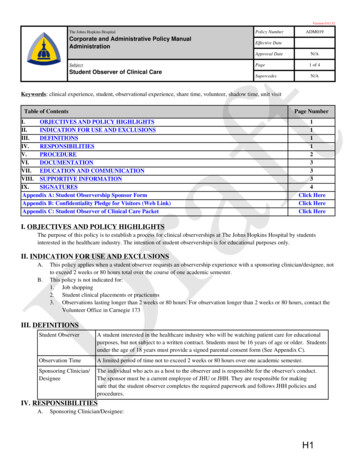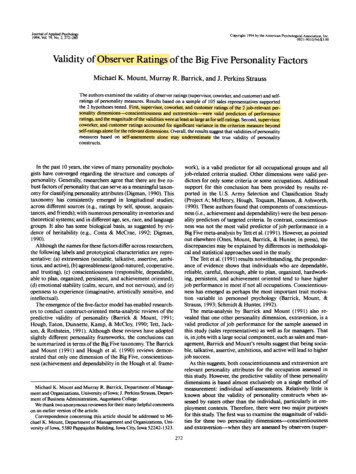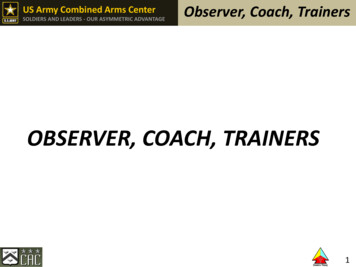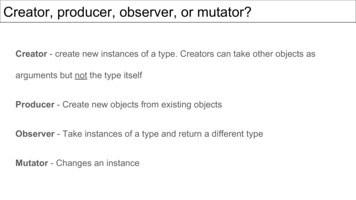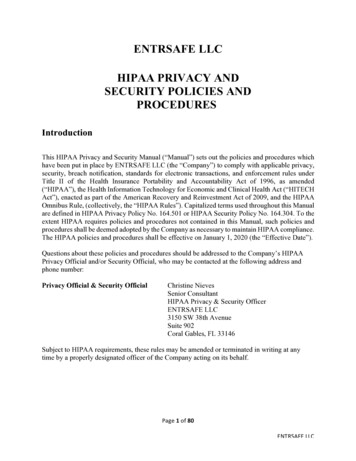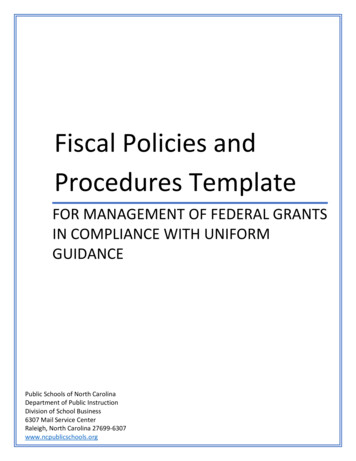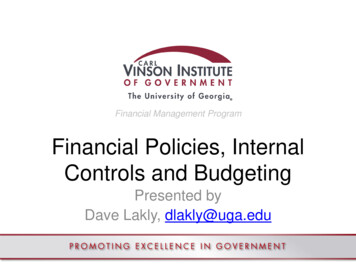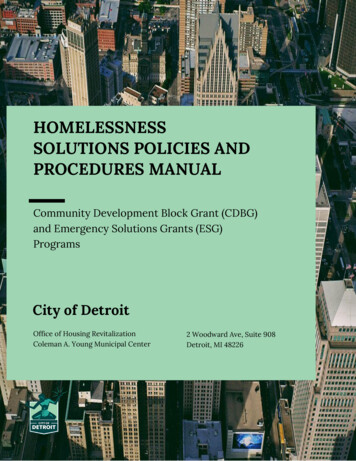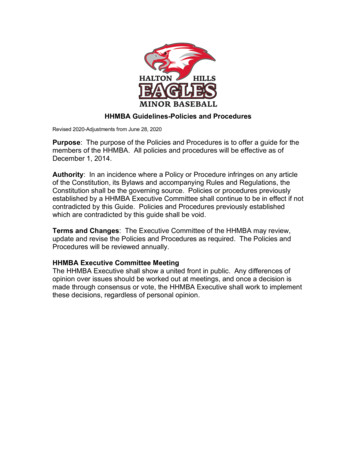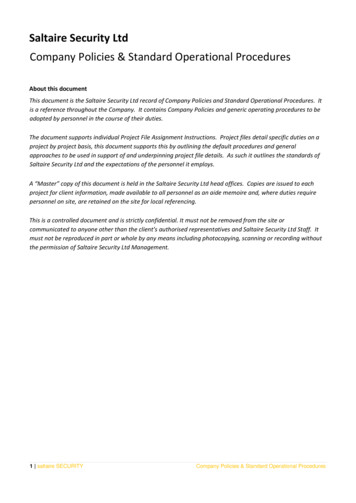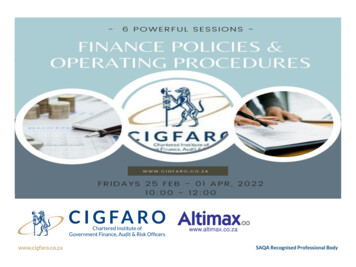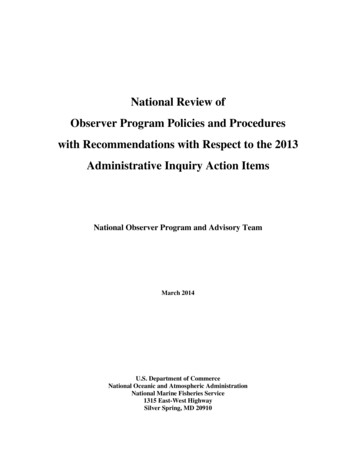
Transcription
National Review ofObserver Program Policies and Procedureswith Recommendations with Respect to the 2013Administrative Inquiry Action ItemsNational Observer Program and Advisory TeamMarch 2014U.S. Department of CommerceNational Oceanic and Atmospheric AdministrationNational Marine Fisheries Service1315 East-West HighwaySilver Spring, MD 20910
Observer Program Policies and ProceduresMarch 27, 20142
Observer Program Policies and ProceduresMarch 27, 2014National Review ofObserver Program Policies and Procedureswith Recommendations with Respect to the 2013Administrative Inquiry Action ItemsNational Observer Program and Advisory TeamNational Marine Fisheries Service1315 East-West HighwaySSMC 3, F/ST, Room 12551Silver Spring, MD 20910www.nmfs.noaa.govU.S. Secretary of CommercePenny PritzkerAdministrator of National Oceanic and Atmospheric Administrationand Under Secretary of Commerce for Oceans and AtmosphereKathryn D. Sullivan, Ph.D.Assistant Administrator for FisheriesNational Marine Fisheries ServiceEileen SobeckMarch 20143
Observer Program Policies and ProceduresMarch 27, 20144
Observer Program Policies and ProceduresMarch 27, 2014Table of ContentsBackground . 6Problem statement. 6Purpose. 81. Develop a uniform, transparent, and consistent procedure for collecting and reporting all potentialmarine resource violations to NOAA OLE, including MARPOL violations . 82. Review safety procedures and ensure that no observers are deployed on vessels that fail to pass thepre-trip vessel safety checklist. . 103.Execute minimum marine safety training and refresher training for observers without exception. . 114. Develop policies and procedures to standardize the legal collection of data on drug and alcohol useduring observer deployments, and forward such information to appropriate law enforcement agencies. . 125. Review current policy and regulations for equal accommodations (accommodations equivalent to thecrew) for observers with particular focus on small vessels that have space limitations. . 136. Develop policies, procedures, and timelines for advance notice given to observers in the event theyare offered a deployment. . 157. Develop a transparent system of tracking observers and their relative placement in line (or therotation) for fishing vessel trips. . 168. Develop a formal communication process for observers to provide any concerns they have about theprogram. . 179. Develop a contractual list of responsibilities for SEFSC Observer Program staff, and duties formanagers of contract observers. . 17Appendix 1. Full Text of Action Items from OIG Report. . 18Appendix 2. Responses from each of the observer programs on Action Items 1-9 from the OIG Report. 20Appendix 3. Summary table of status of action items #1-9 for each of the regional observer programs. . 455
Observer Program Policies and ProceduresMarch 27, 2014BackgroundFisheries observers act as independent monitors to record information from the fishing operations of U.S.commercial fishing vessels and processors. Their resulting data is used by the National Marine FisheriesService (NMFS) to support science, conservation, and management activities that include bycatchreduction, stock assessments, monitoring protected species interactions, gear research, and fisheriesregulations as mandated under the Magnuson-Stevens Fishery Conservation and Management Act(MSA), Endangered Species Act (ESA), and Marine Mammal Protection Act (MMPA).Observers are not directly employed by NMFS; rather, they are the employees of private observerprovider companies contracted by NMFS to manage observer logistics. NMFS is then responsible forensuring that quality data is obtained from these observers. This is accomplished through observertraining before deployment and, in most instances, observer debriefing after deployment. NMFS alsomanages the gear used by observers and their resulting data, specimens, and depositions. In FY 2012more than 900 observers were deployed in 47 fisheries across six NMFS geographical regions—Northeast, Southeast, Southwest, Pacific Islands, Northwest, and Alaska. NMFS has an establishedobserver program in each geographic region to administer the observer-related activities listed above.The National Observer Program (NOP) provides national-level coordination of the regional observerprograms. In addition to handling national program administration, budgeting, and planning, the NOPworks with the regional observer programs to develop national policy, observer data quality standards,and observer and marine safety instructor training standards. Regional observer programs use UpdateForms to document their progress on outstanding issues to the NOP prior to bi-annual meetings.Problem statementOn December 1, 2011, the Association for Professional Observers (APO) and Public Employees forEnvironmental Responsibility (PEER) requested an Office of Inspector General (OIG) investigation of themanagement practices and handling of observer reports regarding vessel non-compliance with fisheriesregulations and other applicable law, and compliance with regulations for observer safety and vesselaccommodations by the Southeast Observer Programs. The APO and PEER claimed that one of theSoutheast Fisheries Observer Programs—the Atlantic Pelagic Longline Observer Program (POP)—disregarded observer reports of vessel non-compliance with applicable regulations and only referred suchreports to the NMFS Office of Law Enforcement (OLE) when requested to do so by OLE. In addition, theAPO and PEER claimed that observers had been pressured by NMFS and their contractor, IAP Services,Inc., to board vessels with unsafe conditions and inadequate accommodations.In response to these allegations, the OIG directed NMFS to conduct an inquiry into the issues raised in thecomplaint and submit a formal response detailing the results (OIG Complaint Action Referral No. PPCCI-12-0221-H). The NMFS Administrative Inquiry that followed was dated January 25, 2013, andincluded a number of action items, responsible parties, and due dates (Table 1, Appendix 1). Upon6
Observer Program Policies and ProceduresMarch 27, 2014review of the NMFS Administrative Inquiry, OIG Complaint Action Referral No. PPC-CI-12-0221-Hwas closed in March 2013.Table 1. Summary of 2013 NMFS Administrative Inquiry Action items.#Entity1Southeast Observer ProgramsOffice of Law Enforcement(OLE)Southeast Observer Programs23Southeast Atlantic PelagicLongline Observer Program(POP)4Southeast Observer ProgramsOffice of Law Enforcement5National Observer Program(NOP)6Southeast Observer Programs7Southeast Atlantic PelagicLongline Observer Program8Southeast Atlantic PelagicLongline Observer ProgramSoutheast Observer Programs91ActionDevelop a uniform, transparent, and consistent procedure forcollecting and reporting all potential marine resource violations toNOAA OLE, including MARPOL1 violationsReview safety procedures and ensure that no observers aredeployed on vessels that fail to pass the pre-trip vessel safetychecklist. Valise life raft should only be used if the vessel’shydrostatic release equipped life raft does not have sufficientcapacity for an observer. The valise life raft shall not be used inlieu of an expired hydrostatic release. Valise life raft is to be used inaddition to, not as a substitute for, the vessel’s life raft if thevessel’s life raft capacity is exceeded.Execute minimum marine safety training and refresher training forobservers without exception (minimum once every three years).Observers should not be allowed to deploy until they havecompleted refresher training.Develop policies and procedures to standardize the legal collectionof data on drug and alcohol use during observer deployments, andforward such information to appropriate law enforcement agencies.These procedures must be covered by the Statement of Work forObserver Contractors. Reportable to the NMFS Deputy AssistantAdministrator for Operations.Review current policy and regulations for equal accommodations(accommodations equivalent to the crew) for observers withparticular focus on small vessels that have space limitations. TheNOP will review potential solutions and alternatives (e.g.technology) to collect data on vessels that are considered too small,inadequate, or unsafe and report to the NMFS Director of the Officeof Science and Technology.Develop policies, procedures, and timelines for advance noticegiven to observers in the event they are offered a deployment.Develop a transparent system of tracking observers and theirrelative placement in line (or the rotation) for fishing vessel trips.Policy shall note the criteria used for substituting observers due togovernment cost-saving efforts (e.g. location/logistics).Develop formal communication process for observers to provideany concerns they have about the program.Develop contractual list of responsibilities for SEFSC ObserverProgram staff, and duties for managers of contract observers.The International Convention for the Prevention of Pollution from Ships (MARPOL).7
Observer Program Policies and ProceduresMarch 27, 2014PurposeThe purpose of this document is to demonstrate that NMFS will comply, as appropriate, with the findingsof the Administrative Inquiry and that all policies, procedures, and controls are consistent across allobserver programs. In their role of oversight, the NOP will review all regional observer programs’policies and procedures as they relate to the Administrative Inquiry and report back to the Director,Science and Technology (S&T) with recommendations. Toward this end, the NOP compiled informationfrom each of the regional observer programs related to the nine action items in Table 1 (Appendix 2).Subsequently the NOP and the National Observer Program Advisory Team (NOPAT) reviewed theinformation and provided recommendations to address gaps in the form of this report. What follows is asummary of those findings and recommendations organized by the items in Table 1. Following therelease of this report, the NOP will report quarterly to the S&T Director on progress toward implementingthe recommendations contained herein.1.Develop a uniform, transparent, and consistent procedure for collecting andreporting all potential marine resource violations to NOAA OLE, includingMARPOL violationsThe primary responsibility of NMFS trained observers is to collect scientific data for management of thefishery. However, another important function of observers is to collect information on potentialviolations that occur during observer deployments onto vessels and into processing facilities. Thesepotential violations are reported by NMFS to OLE, the United States Coast Guard (USCG), and, in somecases, both. Observers are not enforcement agents and thus are not authorized to issue citations, provideregulatory advice, interpret regulations, waive regulatory requirements, or enforce regulations. Thislongstanding NMFS policy is designed to draw a clear distinction between the data collection andreporting requirements of observers and the enforcement of regulations by OLE. This separation ofresponsibilities serves to protect observers from harassment, intimidation, or assault that might occur if anobserver were to attempt to enforce potential violations during an at-sea deployment.Federal regulations provide clear and unambiguous language prohibiting anyone from assaulting,harassing, opposing, impeding, intimidating, or interfering with a NMFS-approved observer (50 CFR§600.725(o), (t), and (u)). Not surprisingly, all observer programs collect data on potential violations thatare considered serious, affect observer safety, involve observer assault or harassment, or include othermajor violations. Furthermore, when cases of alleged assault, harassment, or interference are reported byan observer, the information is immediately relayed from the observer programs to OLE.There is less consistency across observer programs when it comes to their reporting of marine resourceviolations that do not directly affect observer health or safety (e.g., a vessel’s failure to comply withMARPOL). Given the volume, complexity, and sometimes ephemeral nature of regulations that definemarine resource violations, it may be unrealistic to expect observers or even NMFS staff to be aware ofevery potential violation, unless they have studied in maritime law. Prioritization is necessary, andobserver programs have prioritized documentation of potential fishing violations over, for example,MARPOL violations when instructing observers. This prioritization is not the same as ignoring potential8
Observer Program Policies and ProceduresMarch 27, 2014violations. All observer programs train and require observers to document all potential violations, haveprocedures in place to vet the information for completeness, and have ways to report information toappropriate authorities. The Alaskan Marine Mammal Observer program (AMMOP), which primarilymonitors marine mammal interactions with state managed commercial fisheries, in contrast is informed ofpotential marine violations through the observer provider company and not the observers themselves.To summarize, while all but one observer program inform observers of their role in reporting potentialmarine resource violations, it is up to the appropriate authorities to determine whether the potentialviolation is valid, and it is the responsibility of the vessel operators and crew to know and comply with allappropriate regulations (50 CFR § 600.725(k)(w)).RecommendationsFor programs that do not have specific policies and procedures for collecting information on potentialmarine resource violations that include MARPOL, the following materials should be included in observerpolicy documents or training manuals and materials:1) Each observer program training manual will include a section/module on Regulations andCompliance2. The Regulations and Compliance section should be developed jointly by theobserver program and OLE to ensure that the appropriate regulations are included and theprocess for how observer reports are relayed to the appropriate authorities is clearly described.2) Each observer training manual and training materials should include the following specificinstructions:“Observers should monitor for and document compliance infractions and suspected violations intheir logbook and complete a written statement during debriefing. Any compliance issues that arewitnessed should be documented thoroughly in the logbook and the observer program staff, leadobserver, or debriefer should be notified.”3) Each observer program manual should include a section on MARPOL regulations and describewhat information should be collected by observers3.4) Items 1-3 should be covered during observer training, where applicable.5) Each observer program should establish a process for reporting potential regulatory violationsto OLE and/or the USCG, and this process should be documented in training materials.6) Each observer program will report on their progress on items 1-5 above to the NOP in theNOPAT Update Form prior to bi-annual meetings.23See Chapter 20 of the 2013 NPGOP Observer Sampling Manual for appropriate example.See Section 20-20 of the 2013 NPGOP Observer Sampling Manual for an appropriate example.9
Observer Program Policies and ProceduresMarch 27, 2014Review safety procedures and ensure that no observers are deployed on vessels thatfail to pass the pre-trip vessel safety checklist.2.Regulations are in place that require observers to participate in a pre-trip vessel safety orientation andconduct a pre-trip safety check (46 CFR §28.270, 50 CFR §600.746(f)). These regulations specify that,prior to the initial deployment of the observer, the vessel owner or operator (or their designee) mustaccompany the observer on a walk through the vessel's major spaces to ensure that no obviouslyhazardous conditions exist, and that the vessel owner or operator (or designee) must also accompany theobserver in checking the following major items as required by applicable USCG regulations, including: Personal flotation devices/ immersion suits.Ring buoys.Distress signals.Fire extinguishing equipment.Emergency position indicating radio beacon (EPIRB), when required, that is registered to thevessel at its documented homeport.Survival craft, when required, with sufficient capacity to accommodate the total number ofpersons, including the observer(s), that will embark on the voyage.Other fishery-area and vessel-specific items required by the USCG.In addition to these existing regulations, the NOPAT has developed national safety training standards thatinclude specific requirements pertaining to the pre-trip safety checklist4. The national standard states thatthe observer trainee must be able to do the following: Explain the difference between a USCG vessel examination/inspection and a pre-trip vesselsafety checklist.Describe the observer program’s requirements regarding the function of a pre-trip vessel safetychecklist.Describe the procedures [for] completing a pre-trip vessel safety checklist.Understand the observer’s role versus the roles of the USCG and the OLE regarding the pre-tripvessel safety checklist.Describe some of the problems or obstacles in completing the pre-trip vessel safety checklist, andexplain steps to overcome them.Complete a pre-trip vessel safety checklist onboard a commercial fishing vessel, or simulatecompletion of a checklist if a vessel is not available.In this review of the existing observer programs, it has been determined that all applicable programsinclude training on how to conduct a vessel safety check and how to fill out the pre-trip safety checklist(Appendix 3). Each observer program has a list of “no-go” items (i.e., items that if missing, expired, ornon-functional would prevent the observer from deploying). However, these no-go items are not includedin existing regulations, nor is there consistency across programs on which items are included on the no-golist. The NOPAT Safety Committee is in the process of standardizing the list of no-go items on thechecklist among programs to ensure consistency and avoid confusion for observers.4See page 11 m/pdf/Procedural Directive 04-110-01.pdf10
Observer Program Policies and ProceduresMarch 27, 2014Recommendations1) The NOPAT Safety Committee will finalize the list of “No-Go” items and incorporate them intothe national observer safety training standards.2) All “No-Go” items will be clearly identified on the pre-trip safety checklist5.3) Observer programs should explicitly prohibit an observer from deploying if any of the “No-Go”items are missing, expired, or non-functional.4) Observer programs will establish a process for reporting “No-Go” deployments to OLE and/orUSCG to evaluate potential failure to maintain safe conditions for the protection of theobserver(s), refusal to carry an observer, and/or marine safety violations.5) Items 1-4 will be included in program policies, training manuals, and observer training, asapplicable.6) Each observer program will report on the status of this report item on the NOPAT Update Formduring their bi-annual meetings.3.Execute minimum marine safety training and refresher training for observerswithout exception.Safety is a critical component of NMFS observer programs, and all of the programs reviewed here hadsafety training procedures and refresher training programs in place. NMFS observer programs follownational minimum standards that were designed to prepare observers for the hazards associated withcommercial fishing operations (Safety Directive)6. The Safety Directive requires observers to attend ahands-on marine safety training course equating to approximately 2½ to 3 days every 3 years. Safetytraining topics include but are not limited to: risk awareness, conflict resolution, first aid, crisisprevention, emergency response, and survival at sea.Refresher training for observers is critical for reinforcing safety concepts and skills taught during initialmarine safety training. Therefore, NMFS has also included requirements for observer refresher training asa key component of its safety training standards. Refresher training may be taken as part of a NMFS orNMFS-contracted marine safety training, or in the form of a commercially available marine safety coursetaught by an instructor who has completed USCG-certified marine safety instructor training. At aminimum, active observers must be required to attend a hands-on marine safety training course every 3years. Topics to be covered in the observer refresher safety course are at the discretion of each regionalobserver program.In addition to the requirements and policies outlined for observers above, it is important that observer56See Section 19-2 of the 2013 NPGOP Observer Sampling Manual for an appropriate r-Program/pdf/Procedural Directive 04-110-01.pdf11
Observer Program Policies and ProceduresMarch 27, 2014safety trainers remain up-to-date on the latest and best methods to ensure observer safety. Therefore, theSafety Directive also specifies that observer safety trainers must attend marine safety instructor refreshertraining every 2 years (this requirement is currently being revised to every 3 years). NMFS hasdetermined that, at a minimum, observer safety trainers must complete a USCG-approved Marine SafetyInstructor Training course, have prior experience at sea, teach or co-teach at least one marine safetycourse every year, and attend 24 hours of refresher training on relevant topics every 2 years. In addition,at least one trainer from each observer program should co-teach in a different region once every 3 years toensure consistency and broaden shared knowledge.Marine Safety training curricula are reviewed by the NOPAT Safety Advisory Committee for adherencewith the minimum safety training standards described above.Recommendations1) The NOPAT Safety Advisory Committee will continue to review the National Safety TrainingStandards for observers on a regular basis and provide recommendations for improvements orenhancements to the NOPAT. The time period for review should be determined by the SafetyCommittee and approved by the NOPAT.2) Observer programs (and/or their contracted observer providers) will have a documentationand/or notification system to alert observers when their safety training is about to expire.3) Each observer program will report on the status of this item on the NOPAT Update Form duringtheir bi-annual meetings.4.Develop policies and procedures to standardize the legal collection of data on drugand alcohol use during observer deployments, and forward such information toappropriate law enforcement agencies.Drug and alcohol abuse aboard commercial fishing vessels is strictly prohibited. Under 33 CFR § 95 novessel may be operated by an intoxicated individual (defined as any crew member, pilot, or watch standeron any commercial vessel). An individual operating a commercial vessel is considered intoxicated at ablood alcohol concentration of .04 or more, or when the effect of the intoxicant consumed is easilyobserved in the individual’s general appearance or behavior.Observers are instructed to immediately report any drug or alcohol use that affects the observer’s safety totheir respective observer program, and the debriefing process provides an opportunity to document anydrug use aboard the vessel. However, while all observer programs have a policy to notify OLE or otherenforcement officials in cases where drug or alcohol use results in injury or harassment to the observer,most programs do not have a standard process for reporting drug use that did not result in direct injury orharassment to the observer, but was considered a safety concern by the observer.Some programs have policies and procedures in place to report any drug or alcohol use that wasconsidered to impair or compromise the observer's safety, either prior to and leading up to a trip, or12
Observer Program Policies and ProceduresMarch 27, 2014during a trip. For example, the Northeast Groundfish Observer Program has developed “DrugAwareness" training, with the help of the USCG. The training is designed to help observers recognize thesigns and symptoms of possible drug use. Every observer within the North Pacific Groundfish ObserverProgram completes an electronic survey for every vessel they are on board during their post-cruisedebriefing with NMFS, and is asked, “Were alcohol and/or drugs used by vessel personnel to a degreethat you felt your safety was compromised?” An affirmative response would trigger the completion of astatement for forwarding to OLE and/or USCG. The Alaska Marine Mammal Observer Program requirescontracted vessels carrying observers to have in place a code of conduct that prohibits the possession, use,or distribution of all illegal drugs and prohibits excessive drinking of alcoholic beverages.Recommendations1) Observer programs will include information on drug and alcohol use in their training manualsand/or training materials.2) Observer programs will include specific questions during debriefing regarding drug or alcoholuse that compromised the observer’s safety. An affirmative response should be reported to OLEand/or USCG.3) Each observer program will establish a process for reporting drug and alcohol use thatcompromises the observer’s safety to NOAA OLE and/or the USCG, and this process should bedocumented in observer training materials.5.Review current policy and regulations for equal accommodations (accommodationsequivalent to the crew) for observers with particular focus on small vessels that havespace limitations.Lack of adequate accommodations (primarily lack of bunk space and toilet) is a common problem facingobservers and observer programs in many regions. Federal regulations specify that an owner or operatorof a vessel on which a NMFS-approved observer is embarked must provide accommodations and foodequivalent to those provided to the crew (50 CFR § 622.27 (c)(1)). This has been interpreted to meanthat, once deployed onto a vessel, an observer must be treated equal to the crew. Furthermore, regulationsexist that seem to clearly specify vessels cannot fish without an observer if required to carry one. Forexample, 50 CFR §600.74(i) states: “A vessel that would otherwise be required to carry an observer, butis inadequate for the purposes of carrying an observer, as described in paragraph (c) of this section, andfor allowing operation of normal observer functions, is prohibited from fishing without observercoverage.” In addition, there are summary settlement amounts in place to enforce this statute by OLE7.7OLE national and regional Summary Settlement Schedules include new penalties for observer-related violations: interfere withobserver ability to perform duties ( 1,000); ail to demonstrate proof of passing USCG safety examination ( 500); fail to maintainsafe conditions for protection of observers ( 1,000); fail to provide adequate accommodations ( 1,000).13
Observer Program Policies and ProceduresMarch 27, 2014However, the issue of whether a vessel can fish with or without an observer due to accommodationsbecomes more confusing when we consider safety. For example, the MSA (16 USC 1853 §303(b)(8))states: “Any fishery management plan which is prepared by any Council, or by the Secretary, with respectto any fishery, may require that one or more observers be carried on board a vessel of the United Statesengaged in fishing for species that are subject to the plan, for the purpose of collecting data necessary forthe conservation and management of the fishery; except that such a vessel shall not be required to carryan observer on board if the facilities of the vessel for the quartering of an observer, or for carrying outobserver functions, are so inadequate or unsafe that the health or safety of the observer or the safeoperation of the vessel would be jeopardized” (italics added). The MMPA contains similar language inCategory I and II fisheries. Under 50 CFR §229.7 (a)(3) the document states “NMFS, or a designatedcontractor providing observer services to NMFS, may waive the observer requirement based on a findingthat the facilities for housing the observer or for carrying out observer functions are so inadequate orunsafe that the health or safety of the observer or the safe operation of the vessel would be jeopardized”(italics added). The ESA contains nearly identical language. Under 50 CFR §222.404(b) “Consistentwith 16 U.S.C. 1881(b), vessels where the facilities for accommodating an observer or carrying outobserver functions are so inadequate or unsafe (due to size or quality of equ
Develop policies and procedures to standardize the legal collection of data on drug and alcohol use during observer deployments, and forward such information to appropriate law enforcement agencies. These procedures must be covered by the Statement of Work for Observer Contractors. Reportable to the NMFS Deputy Assistant Administrator for .
